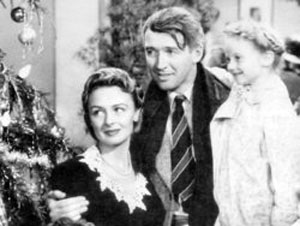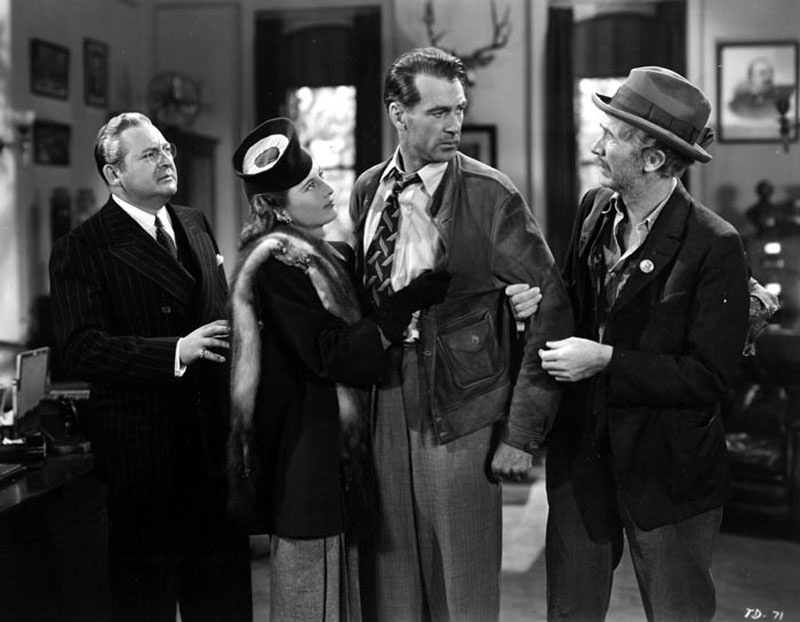

When Frank Capra died, it was inevitable that It's a Wonderful Life would be trotted out to demonstrate his life-affirming, joyous love of people.
The film is a classic, even if it is wildly overexposed, and even if a fluke of paperwork is mostly responsible for its star status. Had its copyright been properly renewed in 1975, It's a Wonderful Life would not have been in the public domain for so many years and thus would not have become, during the '80s, as omnipresent as Christmas carols and shopping days til Xmas.
Granted, it might have joined Miracle on 34th St. and Christmas Carol as beloved, but once a year, holiday movie traditions. But because TV stations were able for so long to repeat it at no cost, it became a Christmas classic ad nauseum.
Yet reading It's a Wonderful Life as wholesomely heart-warming takes uncritically the notion that it celebrates the triumph of small-town sweetness over impersonal modernity.
The miraculous conclusion: Far from being the feel-good movie of 1947, It's a Wonderful Life is in fact one of Capra's most relentlessly depressing works. The film's framing story indeed draws on the backward-looking myth of the small town favored by Hollywood's not-notably rural filmmakers.
Far from being the feel-good movie of 1947, It's a Wonderful Life is in fact one of Capra's most relentlessly depressing works. The film's framing story indeed draws on the backward-looking myth of the small town favored by Hollywood's not-notably rural filmmakers.
But as with the Wizard of Oz, it's what's inside the frame that really counts, and here it is the frame that is Oz, a timeless corner of populist paradise that is counterpoised to the far more realistic — and striking — view of contemporary America in flux that the inner story, Pottersville, represents, a place where the people are as nasty as their oppressors and the individual is unimportant.
This picture of the corruption and the death of small-town society is equaled in film only by Orson Welles' Magnificent Ambersons, a movie given big head start by novelist Booth Tarkington, who specialized in chronicling the corrosive effects of modernization.
Pottersville is as atmospheric a film noir as any of the period's movies, and unlike the wholesome framing story, it seems no inversion of reality at all. It's a realistic, if appalling, view of how things looked to be playing out in the society off the screen.
As it happens, some things did not turn out as badly as Capra seemed to fear. Post-war prosperity (and the federal deposit insurance programs) made bank failures a relative rarity, at least for a few decades, and thrift institutions like George Bailey's building and loan in fact did help underwrite the rise of suburbia, and thus the fulfillment of some Capra-era dreams.
Yet in the same period the country's cities did come more and more to resemble Pottersville, albeit with the added woe of racism. And suburbia itself represented a turning-away from the spiritual strength and communal ties of places like Bedford Falls in favor of materialism and the security of the organization man.
And was Bedford Falls that wonderful anyway? Even in his purportedly wonderful life, George Bailey lives in a town mostly owned by Old-Man Potter. He is saddled with a loser of an uncle, and he is forced to give up his dreams of seeing the larger world and succeeding in a creative career. One of the movie's most visually stunning shots is when George, informed that his brother won't be taking over the building and loan, turns away from his chosen destiny to live up to his obligations at home. He knows Bedford Falls is a trap, and it ultimately drives him to suicide.
In the context of Capra's earlier features, this film looks even grimmer. In It Happened One Night, evil turns up as cynicism and mistrust and in the status barriers that nearly always divide people, issues Capra returns to through all the films that follow. Whatever other adversaries they face, his heroes must always cope with these universal weaknesses, in themselves and in the people around them.
In It Happened One Night that is all they have to do. It takes only an extended one-on-one encounter for the good to prevail. Things get worse.
Gary Cooper in Mr. Deeds Goes to Town is the antithesis of cynicism, mistrust and snobbery; he is small-town virtue personified. The lies and entrenched interests of the city have yet to infect his Bedford Fallsish society, where they are written off as aberrant. Deeds falls prey when he goes to town, but he is more of a threat to the corruptions of a disorganized and internally divided system than it is to him.. Its immorality is localized and in the end little more than traditional American venality, which gives way before Deed's enormous personal virtue.
Venality also motivates the evil in You Can't Take it With You, but here it is more focused, spreading death and destruction as it accumulates power and money. Romantic love is again a victim of cynicism, mistrust and status, while the Vanderhoff's unpretentious virtue (the most precious commodity in Capra's world) just barely survives. This was 1938, after all. The Depression was interminable, war had begun in Asia and was imminent in Europe.
Still, the robber-baron villain comes around in the end when faced with the overwhelming argument presented by simple human goodness just being itself. Even  Edward Arnold, combining the two most loathsome occupations of the Depression (banker/munitions mogul), has a conscience and can be cleansed of his sins and his social baggage and returned to an earlier innocence.
Edward Arnold, combining the two most loathsome occupations of the Depression (banker/munitions mogul), has a conscience and can be cleansed of his sins and his social baggage and returned to an earlier innocence.
Arnold's evil expands in Mr. Smith Goes to Washington, where he is defeated in the end but, unlike in You Can't Take it With You, is left unredeemed. The hero goes up against classic political bossism, but here the evil has become well-organized and wields the extra oomph of modern communications. Despair at first outruns victory, as in most Capra films. (The Vanderhoffs prepare to move out, even if it means betraying the neighborhood. Deeds stands silent in court. Smith collapses in the Senate.) It takes the people, usually assisted by a guilt-ridden retainer of the villain, to clear the way for good to prevail, or at least survive.
In 1941's Meet John Doe, even the people turn on the hero, who again surrenders to despair. Only at the very end do the fundamentally good-hearted citizens admit their wrongheadedness and proclaim their fealty to the virtues Doe represents (ignoring the fact that he himself is compromised by participation in a massive deception). It's a good thing, because the stakes have become higher. The traditional evils of Wall Street manipulators and political bosses have given way to totalitarianism, with Edward Arnold now the leader of a fascist movement.
Edward Arnold, Barbara Stanwyck, Politically, this is as bad as it gets. Morally, however, there was worse to come.
Politically, this is as bad as it gets. Morally, however, there was worse to come.
To be Old Man Potter in It's a Wonderful Life, Lionel Barrymore inverted his own Vanderhoff character in You Can't Take it With You. Where old Mr. Vanderhoff is good and gracious for the joy of it, Old-Man Potter is nasty for its own sake. Prior Capra villains had purpose, whether money, power or a new order. Potter is evil with no goal or reason for being that way. Political and financial empire-building are subsumed into greed, ill will and blind destructiveness.
This evil is so complete that the villain's conversion isn't contemplated. (Significantly, the only conceivable response to Pottersville — which is in fact the real world — is to escape it.) Even the intervention of the people is insufficient to save the hero, whose despair puts him beyond help from human agency. It's true that George's friends and beneficiaries come together to make good the building and loan's shortfall, but that only addresses his superficial and immediate problem. We know what really saves him, what keeps him alive so the community can band together to help: divine intervention.
Capra's group of socially conscious films of the '30s reflected a reasonably coherent fear of the intensifying class conflict, fascism and militarism that seemed then to be overtaking the world. It's a Wonderful Life reveals near panic over the catastrophes and depersonalization that actually did.
Things had become so bad that only God could save the day. Life may be wonderful, but to be able to live it wonderfully is another issue entirely.
The Latest Stuff | Roadside art | Outsider pages | The idea barn | About | Home
Copyright Interesting Ideas 1978